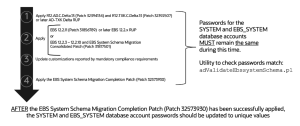EBS System Schema Migration (R12.2)
- System schema migration ‘consolidated’ patch is included in R12.2.11 /R12.2.12 update packs, but the system schema migration ‘completion’ patch is not included, we must apply it separately.
- There are pre-req steps which needs to be satisfied before the schema miration. Thoroughly follow Doc ID 2755875.1 after applying R12.2.11/R12.2.12 patches if you want to migrate completely to EBS_SYSTEM.
- If you are not planning to upgrade to R12.2.11/R12.2.12, but want to avail EBS_SYSTEM feature, you need to apply AD/TXK 13 + System migration Consolidated Patch + then the Completion patch.
- With the AD/TXK 13 & EBS_SYSTEM migration consolidated patch, all EBS database objects that currently reside in the SYS or SYSTEM schemas are migrated to appropriate Oracle E-Business Suite schemas. Depending upon the EBS object type and function, the object is migrated to EBS_SYSTEM, APPS, or APPS_NE.
- The passwords for EBS_SYSTEM and SYSTEM must match until after the Completion Patch is successfully applied. Once the Completion Patch has been successfully applied, the password for EBS_SYSTEM should be changed to be different from the SYSTEM schema password.
- EBS_SYSTEM migration Completion patch drops AD, TXK, and EBS product code in the database SYS or SYSTEM schemas and removes any final restricted references to database SYS or SYSTEM objects.’

- After applying the completion patch, change the EBS-SYSTEM schema passwd different from SYSTEM schema passwd.
- Following migration to EBS System Schema (EBS_SYSTEM), the APPS schema will no longer have the ability to create database directory objects. Database directory objects are now created by the EBS_SYSTEM user.
- The following four standard new database directory objects are created with the privileges shown:
| Object Name | Privileges |
| EBS_LOG | Read/Write |
| EBS_TEMP | Read/Write |
| EBS_INBOUND | Read |
| EBS_OUTBOUND | Write |
- By default, the database directory objects are mapped to a temporary directory in the $ORACLE_HOME on the database tier file system. If a large number of files are written to this directory, your $ORACLE_HOME database tier file system may reach capacity: it is therefore recommended that you instead map the database directory objects to a secure location in a separate mount point from your $ORACLE_HOMEdatabase tier file system. For more information, refer to the Oracle Database documentation for your specific database release.
Recent Posts

